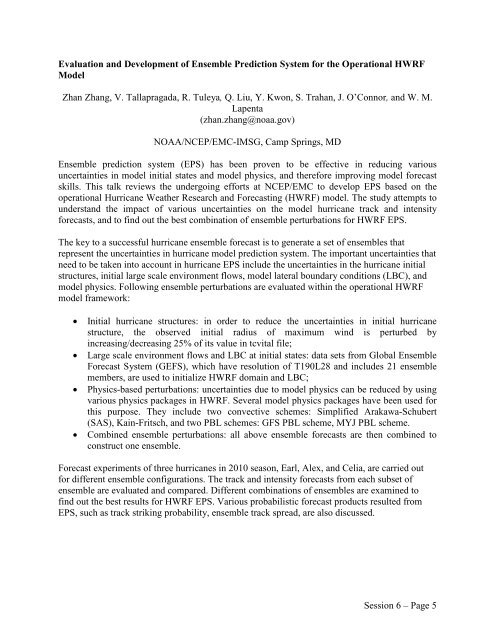65th IHC Booklet/Program (pdf - 4.9MB) - Office of the Federal ...
65th IHC Booklet/Program (pdf - 4.9MB) - Office of the Federal ...
65th IHC Booklet/Program (pdf - 4.9MB) - Office of the Federal ...
Create successful ePaper yourself
Turn your PDF publications into a flip-book with our unique Google optimized e-Paper software.
Evaluation and Development <strong>of</strong> Ensemble Prediction System for <strong>the</strong> Operational HWRF<br />
Model<br />
Zhan Zhang, V. Tallapragada, R. Tuleya, Q. Liu, Y. Kwon, S. Trahan, J. O’Connor, and W. M.<br />
Lapenta<br />
(zhan.zhang@noaa.gov)<br />
NOAA/NCEP/EMC-IMSG, Camp Springs, MD<br />
Ensemble prediction system (EPS) has been proven to be effective in reducing various<br />
uncertainties in model initial states and model physics, and <strong>the</strong>refore improving model forecast<br />
skills. This talk reviews <strong>the</strong> undergoing efforts at NCEP/EMC to develop EPS based on <strong>the</strong><br />
operational Hurricane Wea<strong>the</strong>r Research and Forecasting (HWRF) model. The study attempts to<br />
understand <strong>the</strong> impact <strong>of</strong> various uncertainties on <strong>the</strong> model hurricane track and intensity<br />
forecasts, and to find out <strong>the</strong> best combination <strong>of</strong> ensemble perturbations for HWRF EPS.<br />
The key to a successful hurricane ensemble forecast is to generate a set <strong>of</strong> ensembles that<br />
represent <strong>the</strong> uncertainties in hurricane model prediction system. The important uncertainties that<br />
need to be taken into account in hurricane EPS include <strong>the</strong> uncertainties in <strong>the</strong> hurricane initial<br />
structures, initial large scale environment flows, model lateral boundary conditions (LBC), and<br />
model physics. Following ensemble perturbations are evaluated within <strong>the</strong> operational HWRF<br />
model framework:<br />
• Initial hurricane structures: in order to reduce <strong>the</strong> uncertainties in initial hurricane<br />
structure, <strong>the</strong> observed initial radius <strong>of</strong> maximum wind is perturbed by<br />
increasing/decreasing 25% <strong>of</strong> its value in tcvital file;<br />
• Large scale environment flows and LBC at initial states: data sets from Global Ensemble<br />
Forecast System (GEFS), which have resolution <strong>of</strong> T190L28 and includes 21 ensemble<br />
members, are used to initialize HWRF domain and LBC;<br />
• Physics-based perturbations: uncertainties due to model physics can be reduced by using<br />
various physics packages in HWRF. Several model physics packages have been used for<br />
this purpose. They include two convective schemes: Simplified Arakawa-Schubert<br />
(SAS), Kain-Fritsch, and two PBL schemes: GFS PBL scheme, MYJ PBL scheme.<br />
• Combined ensemble perturbations: all above ensemble forecasts are <strong>the</strong>n combined to<br />
construct one ensemble.<br />
Forecast experiments <strong>of</strong> three hurricanes in 2010 season, Earl, Alex, and Celia, are carried out<br />
for different ensemble configurations. The track and intensity forecasts from each subset <strong>of</strong><br />
ensemble are evaluated and compared. Different combinations <strong>of</strong> ensembles are examined to<br />
find out <strong>the</strong> best results for HWRF EPS. Various probabilistic forecast products resulted from<br />
EPS, such as track striking probability, ensemble track spread, are also discussed.<br />
Session 6 – Page 5
















